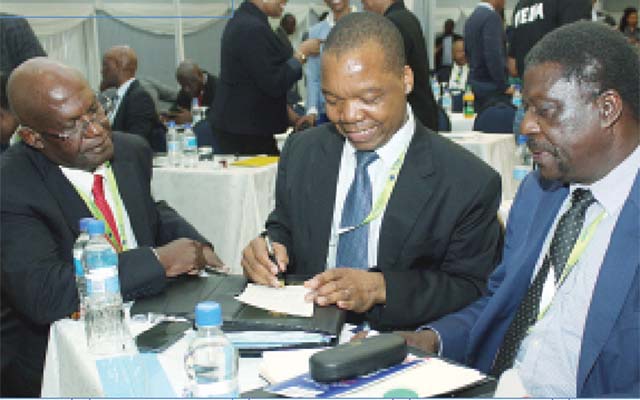ELECTRONIC PAYMENTS CLOCK $5,5 BILLION . . . More people transact in plastic money


Reserve Bank Governor Dr John Mangudya (centre) exchanges notes with the Minister of Industry and Commerce Mike Bimha (right) and BAZ past president and Agribank CEO Mr Somkhosi Malaba at the CZI congress in Bulawayo. (Picture by Eliah Saushoma)
Oliver Kazunga and Prosper Ndlovu Business Reporters
PAYMENTS through the electronic transaction system have jumped to $5,5 billion this month as the country responds to the Reserve Bank of Zimbabwe (RBZ) policy measures meant to ease the prevailing cash crisis.
Central bank Governor Dr John Mangudya said this while addressing delegates at the Confederation of Zimbabwe Industries annual congress in Bulawayo yesterday.
He said following the cash crisis the country has been experiencing in the past few months, RBZ came up with a raft of measures, which have started bearing positive results.
These include increased use of plastic money (using bank cards and other electronic payment systems), reduced electronic transaction costs and daily cash withdrawal limits.
The monetary authority has also encouraged businesses to increase the installation point of sale (POS) machines to promote the use of plastic money.
“If we do some analysis of what’s happening now, so far on electronic payment systems, they have gone up. So, we are thanking Zimbabweans for a good response to the policy measures. Point of sale (POS) machines are working in all the companies, sales are going up in proportionate to the cash sales,” said Dr Mangudya.
“So, that shows you that there’s an increase in July to $5,5 billion worth of total electronic payment systems.”
Dr Mangudya said the foreign currency headache was common across Africa hence withdrawal limits were not unique to Zimbabwe as other countries such as South Africa, Zambia and even the United States were implementing the approach to manage financial flows.
He said bank queues among other negative implications had been reduced as a result of the increased use of electronic payment systems.
Dr Mangudya also said measures were being put in place to curb illicit financial outflows, which he said were haemorrhaging the economy.
He encouraged the transacting public to embrace the plastic money approach to ease demand for hard cash and encouraged businesses to also accept transactions that reflect the prevailing multiple currency system that the country adopted since 2009.
This is meant to reduce demand for the US$, which of late has become a dominant currency given its strong value against regional currencies such as the rand, pula and kwacha.
A number of businesses such as NetOne, fast food giant Simbisa and Government departments are already accepting payments in rand.
Dr Mangudya said Real Time Gross Settlements (RTGs) amounts have also gone up as more people opt to use transfers. “But why do you want to carry all the cash in your pockets? You want cash for three purposes — for transacting purposes, for speculative purpose and for contingent purposes. So, if you’re transacting, it means you want to buy goods from a shop. Just go there and use the POS machine,” he said.
Last month the RBZ cut charges for electronic payments after securing the concurrence of banks and providers of payment platforms agreed to reduce the rates to promote and encourage the use of electronic bank services.
The RTGS charge was reduced to $5 from $10 per transaction while that for POS transactions of up to $10 now costs 10 cents. A customer conducting a POS transaction of above $10 is now charged a maximum of 45 cents.
If a customer uses a POS from their own bank, they will be charged 20 cents. ATM charges, which varied between banks previously, will now cost a maximum $2.50. Monthly administration or service fees are set at a maximum of $5.








Comments